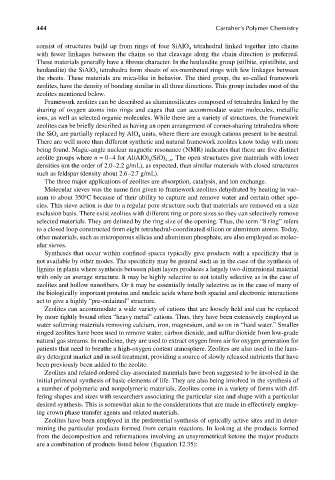Page 481 - Carrahers_Polymer_Chemistry,_Eighth_Edition
P. 481
444 Carraher’s Polymer Chemistry
consist of structures build up from rings of four SiAlO tetrahedral linked together into chains
4
with fewer linkages between the chains so that cleavage along the chain direction is preferred.
These materials generally have a fibrous character. In the heulandite group (stilbite, epistilbite, and
heulandite) the SiAlO tetrahedra form sheets of six-membered rings with few linkages between
4
the sheets. These materials are mica-like in behavior. The third group, the so-called framework
zeolites, have the density of bonding similar in all three directions. This group includes most of the
zeolites mentioned below.
Framework zeolites can be described as aluminosilicates composed of tetrahedra linked by the
sharing of oxygen atoms into rings and cages that can accommodate water molecules, metallic
ions, as well as selected organic molecules. While there are a variety of structures, the framework
zeolites can be briefly described as having an open arrangement of corner-sharing tetrahedra where
the SiO are partially replaced by AlO units, where there are enough cations present to be neutral.
4 4
There are well more than different synthetic and natural framework zeolites know today with more
being found. Magic-angle nuclear magnetic resonance (NMR) indicates that there are fi ve distinct
zeolite groups where n = 0–4 for Al(AlO) (SiO) . The open structures give materials with lower
n 4–n
densities (on the order of 2.0–2.2 g/mL), as expected, than similar materials with closed structures
such as feldspar (density about 2.6–2.7 g/mL).
The three major applications of zeolites are absorption, catalysis, and ion exchange.
Molecular sieves was the name first given to framework zeolites dehydrated by heating in vac-
o
uum to about 350 C because of their ability to capture and remove water and certain other spe-
cies. This sieve action is due to a regular pore structure such that materials are removed on a size
exclusion basis. There exist zeolites with different ring or pore sizes so they can selectively remove
selected materials. They are defined by the ring size of the opening. Thus, the term “8 ring” refers
to a closed loop constructed from eight tetrahedral-coordinated silicon or aluminum atoms. Today,
other materials, such as microporous silicas and aluminum phosphate, are also employed as molec-
ular sieves.
Syntheses that occur within confined spaces typically give products with a specificity that is
not available by other modes. The specificity may be general such as in the case of the synthesis of
lignins in plants where synthesis between plant layers produces a largely two-dimensional material
with only an average structure. It may be highly selective to not totally selective as in the case of
zeolites and hollow nanofibers. Or it may be essentially totally selective as in the case of many of
the biologically important proteins and nucleic acids where both spacial and electronic interactions
act to give a highly “pre-ordained” structure.
Zeolites can accommodate a wide variety of cations that are loosely held and can be replaced
by more tightly bound often “heavy metal” cations. Thus, they have been extensively employed as
water softening materials removing calcium, iron, magnesium, and so on in “hard water.” Smaller
ringed zeolites have been used to remove water, carbon dioxide, and sulfur dioxide from low-grade
natural gas streams. In medicine, they are used to extract oxygen from air for oxygen generation for
patients that need to breathe a high-oxygen content atmosphere. Zeolites are also used in the laun-
dry detergent market and in soil treatment, providing a source of slowly released nutrients that have
been previously been added to the zeolite.
Zeolites and related ordered clay-associated materials have been suggested to be involved in the
initial primeval synthesis of basic elements of life. They are also being involved in the synthesis of
a number of polymeric and nonpolymeric materials. Zeolites come in a variety of forms with dif-
fering shapes and sizes with researchers associating the particular size and shape with a particular
desired synthesis. This is somewhat akin to the considerations that are made in effectively employ-
ing crown phase transfer agents and related materials.
Zeolites have been employed in the preferential synthesis of optically active sites and in deter-
mining the particular products formed from certain reactions. In looking at the products formed
from the decomposition and reformations involving an unsymmetrical ketone the major products
are a combination of products listed below (Equation 12.35):
9/14/2010 3:42:12 PM
K10478.indb 444 9/14/2010 3:42:12 PM
K10478.indb 444

